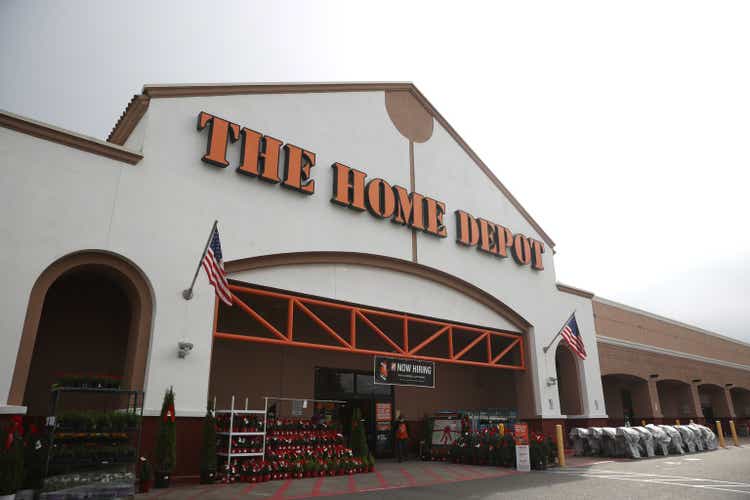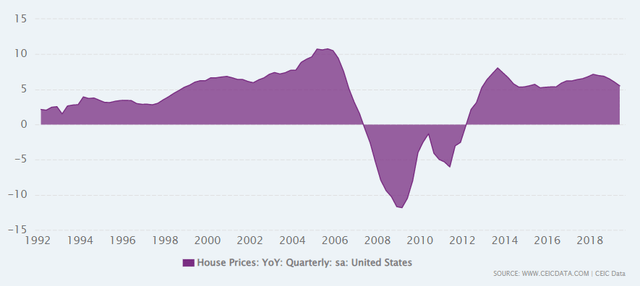Justin Sullivan/Getty Images News
Investment Thesis
Home Depot (NYSE:HD) is the leading home improvement retail company with over 2,300 retail locations across all 50 states in the U.S., Canada, and Mexico. Home prices have been rising steadily over the past decades, and Home Depot’s footprint and revenue have been growing. Leveraging their economies of scale and strong vendor relationships, Home Depot has been able to provide great services to both home owners and pro contractors at a low price. Since my last coverage of HD, management offered guidance that was weaker than expected during the last earnings call, and this caused the stock price to drop. The drop was further exacerbated by recent market volatility. However, I believe it is an overreaction by the market, and Home Depot remains a strong investment for the long-term investor because:
- 4Q 2021 and overall 2021 results were exceptional, demonstrating business strength and the competitive advantage of Home Depot over competitors.
- Future outlook for Home Depot remains strong due to rising home prices and healthy demand for home improvement projects.
- With strong profit margins and exceptional cash flow, the dividend payment is safe and will keep increasing for the foreseeable future.
Exceptional 2021 result
Home Depot is a core holding in my portfolio, and has been outperforming the market for a long time. They reported 4Q 2021 results in late February, and 2021 was another exceptional year. For 4Q 2021, the revenue was $35.7 B (10.7% increase YoY), and net profit was $3.4 B (28% increase YoY). For overall 2021, the revenue increased by 14.4% ($151.2 B in 2021 vs. 132.2 B in 2020), and net profit increased by 27% ($16.4 B in 2021 vs. $12.9 B in 2020). As the CEO said during the earnings call, “Fiscal 2021 was another record year for Home Depot.” I was certainly pleased as a shareholder.
Shareholders might be concerned about inflation and supply chain disruptions, but I believe Home Depot is doing a great job at mitigating those issues. Utilizing their vast network, strong relationship with vendors, and pricing power from their economic moat, Home Depot is controlling their costs and passing increased costs to the consumers. During the last earnings call, management mentioned that comp average ticket has increased by 12.3%, citing inflation in several product categories as the primary reason. The margins decreased slightly (30-35 basis point), but their profit margins are still in line with or above their historical average. So, I don’t see any big red flags.
Strong future outlook
The main driver for Home Depot’s growth is rising home prices. As long as home prices continue to rise, home owners will recognize home improvement projects as an excellent investment and Home Depot will continue to grow. During the last earnings call, management mentioned that the demand for home improvement projects remained strong at all price points. The average home price rose 14.6% in 2021. Due to rising interest rates, some experts are expecting a slower price rise in 2022, as low as 2.9%.
I expect home prices to rise at a rate somewhat in between the low end of 2.9% and the remarkable 2021 level of 14.6%. Ongoing inflation (above 7%) and increases in labor costs are causing construction costs for new houses to shoot up. Also, even with the recent rise, the current mortgage rate (4.75% for 30-year mortgage) is still at a historic low and in line with its 2018-2019 level. Therefore, I expect home prices to rise more along the level of 5-8%, which will positively contribute to Home Depot’s growth. Additionally, the U.S. is still short more than several million houses. So I expect the house price to continue to rise in the long run.
U.S. House Prices Growth (CEIC)
Great profit margins and cash flow
Combining economies of scale, network effect, and brand recognition, Home Depot has one of the strongest economic moats in the retail business. Reflecting this strong economic moat, their profit margins are above the sector median. The 5-year average of EBIT margin (14.7%), EBITDA margin (16.7%), and net income margin (9.7%) are above sector medians by 35-60%. The recent challenges from inflation and supply chain disruption lowered the margin slightly by 30 basis points, but I don’t expect that to be a continuing trend. Also, even with that slight drop, the current margins remain above their 5-year averages.
Reflecting their strong growth and profit margin, Home Depot has been generating lots of cash and rewarding shareholders. In 2021, they generated $16.6 B of operating cash flow, and returned over $21 B to shareholders ($14.8 B in buyback and $7 B in dividend). With a strong future outlook and strong economic moat, I expect them to continue to generate a lot of cash and reward shareholders for the foreseeable future.
Intrinsic Value Estimation
I utilized DCF model to estimate the intrinsic value of Home Depot’s business. For the estimation, I utilized the EBITDA ($26,164M) as cash proxy and current WACC of 8.0% as the discount rate. For the base case, I assumed EBITDA growth of 8% (management expectation) for the next 5 years and zero growth afterwards (zero terminal growth). For the bullish and very bullish case, I assumed EBITDA growth of 10% and 12%, respectively, for the next 5 years and zero growth afterwards. Given the historic EBITDA growth rate is 10%, and the most recent quarter EBITDA growth rate was 13.7%, a growth rate of 10-12% is well within reason.
The estimation showed that the current stock price represents 20-30% upside from the current level. Given the positive outlook on the housing market and strong demand for home improvement projects, I expect Home Depot to achieve this upside easily in the future.
|
Price Target |
Upside |
|
|
Base Case |
$374.73 |
21% |
|
Bullish Case |
$404.83 |
30% |
|
Very Bullish Case |
$437.05 |
41% |
The assumptions and data used for the price target estimation are summarized below:
- WACC: 8.0%
- EBITDA Growth Rate: 8% (Base Case), 10% (Bullish Case), 12% (Very Bullish Case)
- Current EBITDA: $26,164 M
- Current Stock Price: $310.68 (03/25/2022)
- Tax rate: 30%
Risk
The Federal Reserve just announced the interest rate hike schedule for 2022 and 2023 (nine times total). Combining the rate hikes, ongoing inflation, and supply chain disruption, some experts are expecting a slowdown of the U.S. economy. Also, the war between Russia and Ukraine added a whole new level of tensions and uncertainty to the global economy. The slowing economy and uncertainty can negatively impact the growth rate of Home Depot, so investors should monitor the macroeconomic indicators.
As mentioned before, the rising mortgage rate may cool the housing market, which will negatively impact Home Depot’s growth rate. However, given the shortage of houses in the U.S. and rising construction costs, I don’t expect the home prices to slow down too much below the average of the past 10 years (~5-8% per year). Even if house prices slump, I don’t expect it to be a long-term scenario.
Conclusion
Home Depot has been an exceptional investment for the past couple of decades. Riding the rising prices of the American housing market, Home Depot’s revenue and operating cash flow have steadily grown. Given their market leading position and strong economic moat, I expect them to remain a superb investment choice for a long time. Rising interest rates and slowdown in the economy may challenge Home Depot, but I don’t expect it to hurt their long-term growth trajectory. Overall, I expect 20-30% upside from the current level.


Be the first to comment